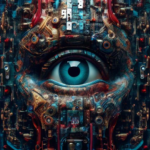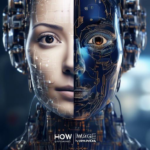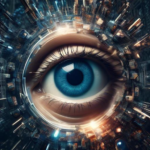In the not-so-distant past, the worlds of art and technology seemed like parallel universes, each thriving in its distinct, vibrant ecosystem. Today, however, they’ve collided in a dazzling explosion of creativity and controversy, birthing the enigmatic field of AI art. As algorithms sketch, paint, and sculpt, venturing into realms once claimed solely by human hands, a plethora of questions and debates have surfaced, challenging our perceptions and ethics. How do we navigate this perplexing landscape, where circuits and creativity intertwine in often unpredictable ways?
Welcome, curious minds and passionate souls, to our exploration of handling controversies in AI art. Here, we’ll uncover the nuances, the excitement, and the respect needed to harmonize innovation and tradition. We’ll traverse through the stormy seas of debate and embrace the wisdom of both critics and enthusiasts, aiming for a balanced compass to guide us through this evolving artistic frontier. Join us, as we delve into the heart of AI art’s most provocative issues, offering supportive insights and practical approaches to foster understanding and creativity in this brave new world.
Table of Contents
- Navigating Ethical Minefields with Empathy and Insight
- Transparency in Creation: The Key to Trust
- Incorporating Diverse Voices and Perspectives
- Balancing Innovation with Cultural Sensitivity
- Establishing Clear Guidelines and Accountability
- Open Dialogues: Fostering Healthy Debates
- Empowering Artists and Audiences Alike
- Striking a Balance: Honoring Tradition While Embracing Change
- To Wrap It Up
Navigating Ethical Minefields with Empathy and Insight
In the evolving realm of AI art, creators often find themselves amidst ethical uncertainties. To approach these challenges with clarity, empathy is as essential as insight. Here are ways to navigate these minefields thoughtfully:
Understand the Perspectives Involved
AI artists should strive to comprehend the viewpoints of other stakeholders—traditional artists, consumers, and AI developers. This demands active listening and considering:
- The value traditional artists place on their craft and the potential impacts on their livelihoods.
- Consumer concerns over authenticity and originality.
- The intentions and responsibilities of developers who create AI tools.
By embracing these diverse perspectives, you cultivate a more holistic view that guides ethical decision-making.
Implement Fair Use and Attribution Practices
Ensuring that any use of reference material adheres to fair use policies and properly attributes original creators is crucial. Ethical usage includes:
- Attribution: Crediting sources even in transformative works.
- Transparency: Disclosing the extent of AI involvement in the creation process.
Foster Open and Constructive Dialogue
Creating platforms for dialogue and feedback can bridge gaps between traditional and AI-driven art communities. Consider organizing or participating in:
- **Workshops**: To educate and share knowledge on AI art ethics.
- **Panels**: Featuring diverse voices including artists, technologists, and ethicists.
- **Forums**: For ongoing, transparent discussions about evolving practices.
Embrace Ethical Guidelines and Collaborations
Adopting ethical frameworks and collaborating with other sectors ensures that AI art progresses responsibly. Here’s how you can contribute:
| Action | Impact |
|---|---|
| Align with AI ethics boards | Guidance on responsible practices |
| Collaboration with human artists | Blending creativity and ethical awareness |
By taking these proactive steps, you help shape a more conscientious and inclusive AI art landscape, promoting not just innovation but integrity too.
Transparency in Creation: The Key to Trust
In the evolving landscape of AI art, maintaining an open dialogue about the creation process is essential to build and uphold audience trust. When controversies arise, it’s crucial to approach them with transparency. This involves being upfront about the methodologies and data sets used in creating AI-generated pieces. Creators should disclose the sources of inspiration, the algorithms employed, and any human intervention undertaken. By doing so, the artistic community can foster a culture of honesty and respect.
**Key practices for transparency:**
- Detailing the **algorithms** and **models** utilized in the creative process
- Providing information on the **training data** and its sources
- Explaining any **human involvement** in the artwork’s final output
Implementing these practices can help bridge gaps in understanding and address any misconceptions. A good example is when a controversy arises over the originality of a piece. By referencing explicit datasets and clarifying how the AI was trained, creators can prove that their work is both innovative and respectful of other artists’ rights. Transparent communication ensures the community remains informed and supportive, rather than suspicious or critical.
Here’s a summary table to illustrate the benefits of transparency:
| Benefit | Description |
|---|---|
| Trust Building | Openness in methodology creates consumer confidence. |
| Educational Value | Transparency educates the public about AI art. |
| Creative Integrity | Proper credit ensures respect for all involved parties. |
Ultimately, the ethical use of AI in art hinges on transparent practices. By openly discussing the mechanics behind AI creations, artists not only enhance their credibility but also contribute to a more informed and appreciative audience. This establishes a robust foundation for creativity to flourish, free from the shadows of controversy.
Incorporating Diverse Voices and Perspectives
One effective way to navigate controversies in AI art is by actively ensuring the inclusion of diverse voices and perspectives. This means going beyond the usual suspects and engaging with individuals from various cultural, social, and professional backgrounds.
Strategies to achieve this include:
- Hosting panel discussions featuring artists, technologists, ethicists, and community leaders.
- Creating open forums for feedback and critiques from different demographics.
- Leveraging online platforms and social media to gather a wide range of opinions and experiences.
For AI art to be truly inclusive, curators and developers should acknowledge the existing biases within AI algorithms. Ensuring diversity in training data is crucial, and this requires active collaboration with diverse communities. Applying a rounded approach and listening to underrepresented voices leads to richer, more inclusive experiences.
Consider the following table as a guideline for diversity integration:
| Action | Impact |
|---|---|
| Integrate diverse datasets | Reduces bias in AI output |
| Consult diverse experts | Enhances creativity and relevance |
| Continuous community engagement | Builds trust and inclusivity |
Moreover, promoting diverse perspectives isn’t only about avoiding controversies but also enriching the art itself. Encounters with varied worldviews foster innovation and creativity, allowing AI art to resonate more deeply with a broader audience. Actively supporting minority artists and creators can lead to a more vibrant and equitable AI art ecosystem.
Balancing Innovation with Cultural Sensitivity
AI-generated art offers a realm of infinite possibilities, but these innovations must also respect cultural values and sensitivities. Creators and developers need to be mindful not to cross boundaries that could result in unintentional offense. **Cultural sensitivity** isn’t just about avoiding controversy—it’s about fostering inclusivity and respect for all communities.
- **Understanding** - Before employing cultural symbols, spending time to learn about their significance is crucial.
- **Representation and Consultation** – Engaging with members of the represented culture ensures authenticity and respect.
When cultural nuances are ignored, AI art can become a ground for misunderstandings and misrepresentations. Utilizing a **multidisciplinary approach** that includes **anthropologists**, **historians**, and **artists** from diverse backgrounds can help bridge gaps. Tools like **database checks** for sensitive or sacred symbols and cross-checks with cultural experts can avert potential controversies.
Developers can also implement **diversity training models** and create an **ethics review board** comprising culture-conscious stakeholders to routinely audit AI projects. This not only ensures adherence to **ethical norms** but also promotes cultural respect. Transparency in these processes is key, allowing the public to see their commitment to cultural sensitivity.
| Action | Benefit |
|---|---|
| Engage Cultural Advisors | Ensure authenticity and respectful representation. |
| Perform Cultural Audits | Avoid cultural faux pas and controversial representations. |
By publicly acknowledging and integrating these practices, creators of AI art can position themselves not only as tech innovators but also as global citizens who value and respect cultural diversity. This holistic approach ensures that AI art isn’t just innovative but also culturally resonant and sensitive.
Establishing Clear Guidelines and Accountability
One of the most effective ways to navigate the complexities surrounding AI-generated art is to set **definitive guidelines**. Clear standards ensure that everyone involved—from artists to consumers to tech developers—understands the boundaries and expectations. These guidelines should cover aspects like copyright issues, ethical considerations, and credit attribution. By having these in place, the grey areas become more black and white, reducing misunderstandings and controversies.
**Accountability mechanisms** play a crucial role in maintaining the integrity of these guidelines. It’s essential to establish **systems for reporting infractions** and a process for handling disputes. For instance, AI Art Forums could have a designated committee to address complaints and ensure fairness in decision-making. Here’s an example of how responsibilities could be divided:
| Role | Responsibility |
|---|---|
| Artist | Adhere to ethical standards and provide accurate credit. |
| Platform Admin | Moderate content and handle reports of misuse. |
| Committee | Resolve disputes and enforce guidelines. |
**Transparency** is essential to foster trust in AI art communities. Keeping records of decisions, transparency in guideline updates, and open communication channels are pivotal. Consider creating a publicly accessible archive of all decisions made regarding disputes and guideline changes. This can help people understand the rationale behind each decision and hold the right entities accountable.
Implementing **training sessions and workshops** focusing on ethical AI art practices can further reinforce these guidelines. Such initiatives can help creators and consumers become more aware of the ethical implications and best practices when dealing with AI-generated art. Listeners can gain valuable knowledge on identifying potential issues and proper channels for reporting any problems they encounter.
Open Dialogues: Fostering Healthy Debates
In the evolving world of AI art, controversy may arise due to differing opinions about the role of technology in creative processes. Engage in open dialogues to create a productive and respectful environment for debates.
**Encourage Respectful Communication:** Promote an atmosphere where participants feel comfortable sharing their viewpoints. Ensure that interactions are polite and constructive. Here are some strategies:
- Use **inclusive language** to avoid alienating any group.
- Avoid **personal attacks** and focus on the ideas being discussed.
- Practice **active listening** to understand other perspectives.
**Foster Understanding through Education:** Educate participants about the technical and ethical dimensions of AI art. Consider creating resources or organizing workshops to clarify the following:
- The technical capabilities and limitations of AI in art creation.
- Ethical implications, such as copyright and ownership concerns.
- The broader impact of AI on traditional art forms.
**Use Structured Formats for Debates:** Implement structured formats to ensure that debates remain focused and productive. Some effective formats include:
- **Panel discussions** with experts holding diverse views.
- **Round-table discussions** allowing equal speaking opportunity.
- **Mediation sessions** for resolving particularly heated disputes.
**Highlight Common Ground:** Identify and emphasize areas of agreement that can serve as a foundation for further discussion. This could be related to shared goals such as advancing the field of AI art responsibly. Here is a simple approach to find common ground:
| Aspect | Common Ground |
|---|---|
| Purpose | Innovating art |
| Ethics | Responsibility |
| Impact | Art evolution |
Empowering Artists and Audiences Alike
- Opening Dialogue: Engage with both artists and audience members through open forums and social media platforms. Encourage discussions about the benefits and ethical considerations of AI-generated art. This way, you not only educate your audience but also give artists a chance to express their thoughts and concerns. Initiating conversations helps build a deeper understanding and paves the way for mutual respect.
- Transparency: Artists should inform their audience when a piece of art has been created with the assistance of AI. Transparency fosters trust and allows the audience to appreciate the blend of human creativity and technological innovation.
To amplify the voices of artists and audiences alike, consider holding interactive workshops and webinars. These could cover topics like ethical considerations, creative techniques, and the future of AI in the art world. This not only promotes skill development among artists but also educates the public on the opportunities and pitfalls of AI involvement in creative work.
| Platform | Purpose | Format |
|---|---|---|
| Forums | Community Discussions | Text-Based |
| Social Media | Engagement & Polls | Multimedia |
| Workshops | Skill Development | Interactive |
| Webinars | Education | Live Video |
- Mutual Support: Fostering a culture of mutual support can create a safe space for both parties to express their views. Encourage seasoned artists to mentor novices on integrating AI tools in their workflow ethically and effectively.
By giving a voice to both artists and the audience, you lay the groundwork for nuanced and informed conversations. Together, you can celebrate the creative potential of AI while addressing its controversies with sensitivity and insight. This collaborative approach not only empowers individual creators and consumers but also strengthens the entire community.
Striking a Balance: Honoring Tradition While Embracing Change
In the ever-evolving world of AI art, blending the reverence for artistic tradition with the excitement of technological innovation is crucial. As creators and enthusiasts, it’s important to navigate controversies thoughtfully, ensuring that modern advancements honor the rich legacy of art.
To strike this delicate balance, consider the following approaches:
- Understand the History: Learning about art movements, traditional techniques, and cultural significance can provide a profound context. This respect for history informs your work with depth and authenticity.
- Foster Dialogue: Engage both traditional artists and tech pioneers in conversations about AI art. Creating forums and discussion panels can help bridge the gap, promoting mutual respect and understanding.
- Set Ethical Standards: Develop a personal code of ethics that guides your creative process. Make it clear how you address issues like copyright, originality, and responsible use of AI.
An effective way to handle potential conflicts is through transparency and education. Consider the following strategies:
- Open Source Projects: Share your methodologies and AI models openly to demystify the technology behind your art.
- Workshops and Webinars: Host sessions to teach others about AI art, its benefits, and limitations, creating a more informed audience.
- Documentation: Maintain detailed project logs that document the creative process, emphasizing the human element and decision-making involved.
Moreover, it is essential to have a structured approach to discussing controversies publicly:
| Controversial Issue | Action Plan |
|---|---|
| Copyright Infringement | Develop clear guidelines and respectfully credit original artists. |
| Authenticity Concerns | Be transparent about AI’s role and highlight human contributions. |
| Ethical Dilemmas | Create an ethical framework and openly discuss challenges and solutions. |
Balancing tradition and innovation in AI art isn’t merely about choosing between the old and the new. It’s about crafting a narrative that honors the past while eagerly anticipating the future, fostering a more inclusive and enriching artistic landscape for all.
To Wrap It Up
embracing controversies in AI art is an opportunity for growth and learning. By engaging in open dialogue, staying true to your artistic vision, and being mindful of ethical considerations, you can navigate the challenges that may arise with grace and resilience. Remember, art is a reflection of society and should spark conversations that push boundaries and challenge perceptions. So, keep creating fearlessly, knowing that your voice matters in shaping the future of AI art. Embrace controversies as stepping stones towards a more vibrant and inclusive artistic community. Here’s to pushing the boundaries of creativity and innovation in the ever-evolving world of AI art!
































